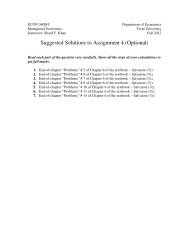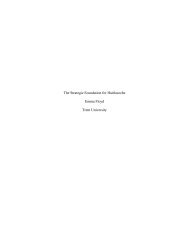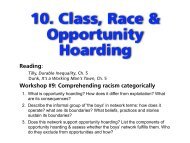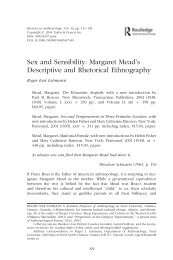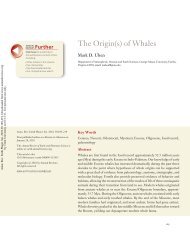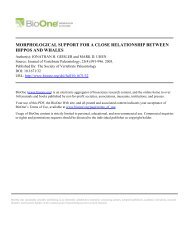REO FORTUNE'S PSYCHOLOGICAL THEORY OF CULTURAL ...
REO FORTUNE'S PSYCHOLOGICAL THEORY OF CULTURAL ...
REO FORTUNE'S PSYCHOLOGICAL THEORY OF CULTURAL ...
You also want an ePaper? Increase the reach of your titles
YUMPU automatically turns print PDFs into web optimized ePapers that Google loves.
Fortune’s Theory of Cultural Ambivalence<br />
279<br />
one’s personal views and dominant views in one’s culture. Fortune called<br />
greater openness to enculturation “suggestibility.” Humans need to have<br />
strong suggestibility in order to achieve good social agreement, but this<br />
threatens individuality. Dreaming evolved to allow individual contrariness<br />
to express itself in emotionally satisfying ways without endangering sociality<br />
(Fortune 1927: 85–86).<br />
Fortune evidently considered a degree of individual resistance to suggestibility<br />
to have conferred a selective advantage in human evolution,<br />
though he did not spell out what this would have been. Subsequent research<br />
has shown that dreaming is common to all mammals, except possibly egglaying<br />
species, indicating that the evolutionary origins of dreaming must be<br />
sought long before the hominid line and its reliance on culture evolved<br />
(Hunt 1989, 26).<br />
Regardless of how dreaming evolved in human ancestors, Fortune’s<br />
explanation offers the anthropologically useful observation that dreaming<br />
can function socially by allowing people to express views that go against<br />
those prevailing in the surrounding society. Curiously, his own recounted<br />
dreams do just the opposite: they express majority views lurking in the<br />
mind of a social rebel. The agnostic becomes a Christian, the pacifist<br />
becomes a warrior, and so on. Evidently, it can go both ways: the waking<br />
view can either agree or disagree with the majority view in the surrounding<br />
culture, and the dreaming view can disagree with the waking view. In both<br />
types of internal conflict, Fortune’s formulation, like other psychodynamic<br />
approaches, has important implications for a sophisticated anthropology of<br />
cultural storage and transmission, because it offers a composite model of<br />
the individual as a culture-bearing being (Hollan 2000). Such work reminds<br />
us that to be enculturated in one’s tradition is not simply to agree with it.<br />
People are often almost literally of two minds: one might agree with others<br />
in dreams but not when awake, or vice versa.<br />
Fortune’s ideas about dreaming, though not directly influential in<br />
psychology or anthropology in his own time, and apparently only indirectly<br />
influential in setting his own ethnographic agenda, are nevertheless echoed<br />
in subsequent and current scholarship. I mention two examples. First,<br />
psychologist C. G. Jung ([1945] 1960) took an interest in the same sorts of<br />
dreams as Fortune considered. Jung labeled them “compensatory dreams”<br />
and saw them as functioning to restore intrapsychic balance by calling<br />
attention to neglected aspects of personality that are striving for expression<br />
(Koulack 1993).<br />
Second, anthropologist Michele Stephen proposed a model of memory<br />
and dreaming that resembles Fortune’s ideas about verbal and emotional<br />
knowledge, each using distinct memory systems:<br />
pacs-32-02-06.indd 279 9/7/2009 2:32:33 PM



